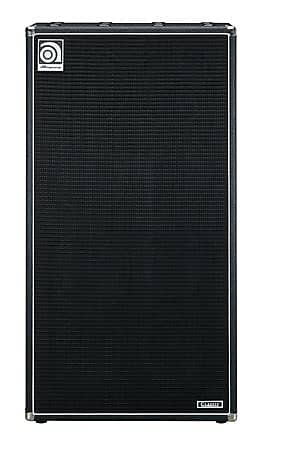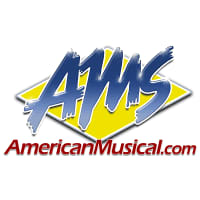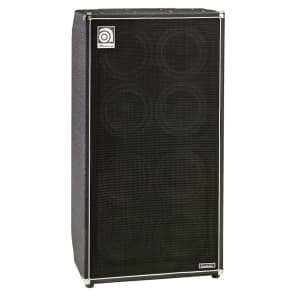
The Ampeg SVT-810E has absolutely no problem bringing the thunder without getting muddy!
With incredible designs delivering the undeniable tone of this SVT-810E, Ampeg enclosures have set the standard for decades. This is the speaker enclosure people mean when they say SVT speaker cabinet. It's all about tone. Other than the color scheme, it is identical to the original SVT-810.
Why eight 10 inch speakers? Ampeg learned early on that 10 inch speakers work much more efficiently than fifteens or eighteens - and if you put eight 10 inch speakers together, you can move a huge column of air. You'd need five 18 inch or six 15 inch speakers to move as much air as the SVT-810E! And they simply wouldn't be able to respond to transient peaks as quickly as these tens.
The SVT-810E is still manufactured using the same design dating all the way back to 1969. The Infinite Baffle design of these sealed enclosures produces vast amounts of tightly focused bass. That's why you'll find the SVT-810E on stage with such artists as Chris Squire (Yes), Geezer Butler (Black Sabbath), John McVie (Fleetwood Mac), and far too many others to list here. In the world of high performance bass cabs, the Ampeg SVT-810E stands tall and proud.
SVT-810E Features
The History of AMPEG...
In 1946, Everette Hull, an acomplished pianist and bass player, organized a partnership with Stanley Michaels under the name Michaels-Hull Electronic Labs. Their mission was to produce a new microphone pickup that Hull designed. The pickup was fitted on the end of an upright bass and was dubbed the Amplified Peg or Ampeg for short.
In 1949, Hull became the sole proprietor and changed the name of the company to the Ampeg Bassamp Company. Since that time, Ampeg has produced some of the music industry's most innovative and memorable products, satisifying the needs of musicians all over the world. Many of these products feature incredibly unique features and performance capabilities resulting in six U.S. patents under the Ampeg brand name.
In 1960, a design engineer by the name of Jess Oliver created a combo amplifier with a chasis that could be inverted and tucked inside the speaker enclosure, protecting the inner workings and increasing the portability of the the amp. Nicknammed the Portaflex, this amplifier became the standard in bass combos throughout the 60's and 70's.
Also in the early 60's, Ampeg was the first company to incorporate reverb in an amplifier. The Reverbrocket preceded Fender's Vibroverb (often thought of as the original) by nearly 2 years. In 1969, Ampeg set out to design the most powerful amplifier ever made. At that time, 50-watt amps were considered more than adequate. 100-watt amps were considered plenty loud. Ampeg, however, not only harnessed 300 watts of pure tube power but actually created a new valve (tube) technology - Super Valve Technology, or the SVT. Now the most sought after stage amplifier, the SVT has proven its road worthiness on stages around the world.
In 1986, St. Louis Music, Inc purchased Ampeg and continues the tradition of making quality, musician-satisifying products. The current series of Ampeg Classic models, Pro Series products, B Series heads and combos as well as the updated re-issue Diamond Blue Series are among the latest in the evolution of the professional, innovative and feature laden amplifiers available.
With incredible designs delivering the undeniable tone of this SVT-810E, Ampeg enclosures have set the standard for decades. This is the speaker enclosure people mean when they say SVT speaker cabinet. It's all about tone. Other than the color scheme, it is identical to the original SVT-810.
Why eight 10 inch speakers? Ampeg learned early on that 10 inch speakers work much more efficiently than fifteens or eighteens - and if you put eight 10 inch speakers together, you can move a huge column of air. You'd need five 18 inch or six 15 inch speakers to move as much air as the SVT-810E! And they simply wouldn't be able to respond to transient peaks as quickly as these tens.
The SVT-810E is still manufactured using the same design dating all the way back to 1969. The Infinite Baffle design of these sealed enclosures produces vast amounts of tightly focused bass. That's why you'll find the SVT-810E on stage with such artists as Chris Squire (Yes), Geezer Butler (Black Sabbath), John McVie (Fleetwood Mac), and far too many others to list here. In the world of high performance bass cabs, the Ampeg SVT-810E stands tall and proud.
SVT-810E Features
- Tilt Back Handle Bar
- 1/4 inch and Neutrik Speakon Jacks
- Baltic Birch Plywood
- Heavy-Duty Recessed Wheels
- Skid rails
- SVT-CL Head Color-Scheme
The History of AMPEG...
In 1946, Everette Hull, an acomplished pianist and bass player, organized a partnership with Stanley Michaels under the name Michaels-Hull Electronic Labs. Their mission was to produce a new microphone pickup that Hull designed. The pickup was fitted on the end of an upright bass and was dubbed the Amplified Peg or Ampeg for short.
In 1949, Hull became the sole proprietor and changed the name of the company to the Ampeg Bassamp Company. Since that time, Ampeg has produced some of the music industry's most innovative and memorable products, satisifying the needs of musicians all over the world. Many of these products feature incredibly unique features and performance capabilities resulting in six U.S. patents under the Ampeg brand name.
In 1960, a design engineer by the name of Jess Oliver created a combo amplifier with a chasis that could be inverted and tucked inside the speaker enclosure, protecting the inner workings and increasing the portability of the the amp. Nicknammed the Portaflex, this amplifier became the standard in bass combos throughout the 60's and 70's.
Also in the early 60's, Ampeg was the first company to incorporate reverb in an amplifier. The Reverbrocket preceded Fender's Vibroverb (often thought of as the original) by nearly 2 years. In 1969, Ampeg set out to design the most powerful amplifier ever made. At that time, 50-watt amps were considered more than adequate. 100-watt amps were considered plenty loud. Ampeg, however, not only harnessed 300 watts of pure tube power but actually created a new valve (tube) technology - Super Valve Technology, or the SVT. Now the most sought after stage amplifier, the SVT has proven its road worthiness on stages around the world.
In 1986, St. Louis Music, Inc purchased Ampeg and continues the tradition of making quality, musician-satisifying products. The current series of Ampeg Classic models, Pro Series products, B Series heads and combos as well as the updated re-issue Diamond Blue Series are among the latest in the evolution of the professional, innovative and feature laden amplifiers available.
| Condition | Brand New (New) Brand New items are sold by an authorized dealer or original builder and include all original packaging.Learn more |
| Brand | |
| Model |
|
| Categories |



